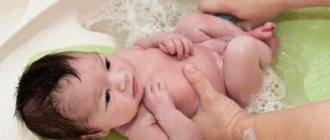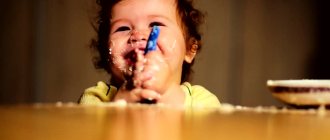Diapers are expensive, and in a crisis you want to save money. To save on diapers, you can use early child care. This procedure will not only reduce the waste of material resources, but also reduce the time for swaddling the baby.
Many mothers also hope that earlier planting will help potty train their child. You should figure out whether this procedure helps you make friends with the potty. We will also learn how to teach a child to relieve himself at a certain moment, and how to properly seat the child.
Now let's look at this in more detail.
What is it - planting
Some people think that planting is when a child is placed on a potty from birth. Others say that it is when a child is held over a basin or sink while he begins to grunt and fart to make the process easier for him. Dropping off the newborn
- this is the interaction between a parent and a child when an adult, watching the baby, understands when and how the child needs to help. From birth, children learn to control their bodies, try and realize their capabilities. By dropping off the child, parents simply help him understand what and how is happening to his body.
How it happens
If from the first days you do not pack the child in a disposable diaper, but watch him, then pretty soon an attentive parent will see how and when “big and small things” happen to the baby. Most often, newborns empty their intestines after sleep and during sucking.
, so breastfeeding can be successfully combined with the first planting experiments.
To do this, the child needs to be held at the breast with a bare bottom and at the first signs of anxiety - spinning, grunting, straining, etc. – hold it over a small basin, without lifting it from your chest. After eating, babies usually fall asleep. To wake up after some time (it’s different for everyone) and relieve yourself again. Being wet and dirty is unpleasant, so the child calls his mother
, who will change him and change his clothes.
If the baby sleeps in a disposable diaper, he will not be wet. And after a while he will stop waking up, doing his business half asleep. On the one hand - wonderful. The child sleeps longer, the mother is happy. But, on the other hand, after some time the baby’s diaper will still need to be removed. And then the child, accustomed to always being dry
, without a diaper, will “swim at night.” And the mother will have to put in a lot of work to teach the child to pee on the potty at night, and not in bed, as he got used to in the first year or two.
Symptoms
The main signs of constipation in newborns are rare stools, accompanied by the baby's crying, and decreased appetite. This reaction occurs due to the fact that the stool is too hard, making it difficult for the baby to empty the intestines.
How to help your baby:
- First of all, change mom’s diet.
- You can give a small enema with chamomile.
- Give a tummy massage.
- With mixed feeding, you can avoid it by changing the complementary feeding mixture.
Constipation in breastfed newborns is most often caused by foods that “strengthen.” Mom needs to limit the consumption of the following products:
- hard cheeses;
- rice dishes;
- boiled and fried potatoes;
- baked goods;
- hard cheeses.
Completely eliminate from the diet foods that cause constipation in a newborn baby, such as:
Constipation in a bottle-fed baby most often stops with the replacement of the formula. The same advice will help prevent constipation in a newborn during mixed feeding. From the age of 6 months, additional foods are introduced into the child’s diet. At this stage, the causes of constipation in newborns lie precisely in them. There are a number of foods that can interfere with the passage of stool.
For constipation it is not recommended:
Catch Me If You Can
All children express their desire and impatience in different ways. Some are spinning and whimpering, others are screaming loudly. The signals also differ in time. Typically, newborns
and children under 3 months “honk” very actively. At this time, even an inexperienced mother can easily achieve 100% planting “at the child’s request.”
Often after 3 months or before crawling, children gradually stop “honking” during the day
. At this time, you can plant the child “at the request of the mother,” that is, at the same time when the potty is usually offered to older children - before a walk, before bed, before being taken to the table or in a sling. To make your life easier, you can cover all surfaces with waterproof sheets and give your child freedom - let him explore his capabilities and enjoy the process.
At night
The baby, as before, will toss and turn and wake up slightly; these stable night “signals” will help you successfully continue planting. As a rule, babies do not pee or poop in their sleep; for such important matters, they almost always wake up slightly, toss and turn, and sometimes whine. This is where we can help them.
Let's draw conclusions
Early planting is a useful procedure, regardless of material income, so it can and should be practiced. At the same time, you need to learn to determine the baby’s desires and urges by his behavior. By forming a conditioned reflex, you can make the baby pee and poop when the mother needs it. When disembarking, press the baby’s legs to the tummy; you need to wait 2-3 minutes if the little one does not relieve himself immediately.
In this video, a mother shares her experience of leaving her baby early:
We plant at night
The hardest thing about dropping your baby off at night is deciding
on this.
If the most difficult stage is passed, we begin preparation. To successfully plant a newborn, you will need to organize the space
in the bedroom so that you are as comfortable as possible, because at night you want to sleep and not deal with various issues.
If you practice co-sleeping, it will be quite easy for you to start placing your baby, especially if you are breastfeeding. For this, a small basin will be useful, which will always stand next to
the bed
, or under it.
When you hear your baby tossing and turning, offer him your breast. If he doesn't calm down and fall asleep right away, he probably needs to be dropped off. You can do this without lifting your chest. Hold the baby over the basin
in a knee-elbow position or whatever is more comfortable for you and him.
Having done his business, the child will quickly fall asleep again. On average there may be three or four such times per night, or maybe more or less. If your baby sleeps in a separate crib, bassinet or bassinet next to the parent's bed, it will be more difficult for you to hear him
.
You may find your baby already wet more often. Try to plant it anyway, even if it is already wet. And then everything will need to be rearranged. In both cases, it will be easier for you if you cover the bed with a waterproof sheet
. Then you won’t have to dry the mattress. You will also find reusable waterproof diapers useful, which are convenient to use in a crib or cradle, and for safety on a large bed. You can read more about this here.
Additional products to help your baby with colic
The most effective means for relieving a child of painful sensations from colic are the use of heat, abdominal massage, gymnastics and fitball exercises, and diet by a nursing mother.
Hot water bottle on the stomach
Using dry heat improves blood circulation and eliminates pain and muscle spasms. The main difference between heating pads is their filling, which allows you to retain heat for as long as possible.
The following options are available for sale:
- A water heater is a container made of rubber or silicone into which hot water is poured. It is used like this: heat the liquid to a temperature of 60 C, pour 2/3 into the heating pad and release excess air. Then the container is tightly sealed and turned over, checking whether water flows out. After this, the heating pad is wrapped in cloth or placed in a case intended for it.
- Electric heater. It is made from natural fabrics, electrical conductors are sewn inside it, and their temperature is regulated by a thermostat. It is not recommended to purchase a device without a regulator, so as not to burn the child’s skin. Heating occurs within 5 minutes.
- Salt hot water bottle. The product is characterized by uniform heating and slow heat release, which lasts up to 3-4 hours. It heats up to a temperature comfortable for human skin; such a device is absolutely safe for babies.
- Dry heating pad. The product involves the use of dry filler; it can be activated from any heat source, for example, a battery, microwave, oven. The surface of the heating pad is made of natural fabrics.
Instructions: place the device in the microwave oven at the highest power and heat for 1 minute. Place in the oven for 15 minutes. at a temperature of 80°C. The warm bag is placed in a soft toy and placed on the baby’s stomach for 5 minutes.
- Gel heating pad. Its size can be adjusted with Velcro on the belt. The gel battery is lowered into a container of water so that the liquid completely covers it. Then the container is placed in the microwave for a maximum of 1 minute. The temperature of the heating pad for infants should be no more than 50 C.
Gel heating pad
The battery can also be heated with boiling water; to do this, you need to leave it in the water for 3-4 minutes. If the appliance becomes too hot, wait until it cools down. Then you need to remove the battery from the water, blot it with a towel, and only then insert it into the belt that is put on the newborn’s body.
The duration of heating the abdomen is the same in all cases - 5 minutes. If the heating pad does not have a fabric base, it is wrapped in a towel and then applied to the baby’s abdominal cavity.
Massage
It will be more effective to relieve newborns from colic if you massage the baby’s abdomen before the procedure. The procedure should take no more than 7 minutes. According to pediatricians, longer manipulation does not bring relief to babies, but, on the contrary, causes discomfort.
The massage is done with stroking, light, pinching and wave-like movements. It is important that all circular actions are performed clockwise - only this direction allows you to remove gases from the intestines and improve peristalsis.
How to massage for colic in a newborn:
- Hands need to be rubbed together to warm up, placed on the baby’s stomach and held for a few seconds. Then, with light pressure, you need to perform circular movements. With each circle, the pressure can be gradually increased, avoiding the right hypochondrium.
- Holding your hands on the abdominal cavity, alternate pressure is applied first with one and then with the other hand. After this, they move on to stroking the abdomen, remembering the direction, and then move their hands from top to bottom.
- Next, you need to stroke the oblique muscles, starting from the sides and moving towards the navel area. Children's massage therapists recommend stroking the central part of the abdomen clockwise with your fingertips. Then, alternate movements of the hands, making stroking movements from top to bottom.
- Next, the baby’s legs are bent at the knee joint and pressed tightly to the stomach for a few seconds. At this moment, you can hear gases coming out of the baby. Finally, the stomach and legs are stroked.
We plant during the day
To make it easier to drop off during the day, the child should be kept in one blouse (and socks, if it is very cold). You also need to stock up on regular diapers, which will help eliminate “slips” and save your clothes when you are holding your baby in your arms. Watch the child, he usually gives a “signal”
, before something happens.
You can keep a small diary, noting sleep, food and “wet things” in it. After just a few days of observation, you will see certain patterns
and rhythms in the child’s behavior.
These rhythms can be relied upon when your intuition and baby's signals are silent. You can offer your child to drop off simply because you feel it’s time
.
Prevention of constipation in infants
To avoid such violations, you must take a lot of walks: fresh air benefits every person. In this case, there is no need to wrap the child up; he should be dressed according to the weather.
Every mother tries to be a little doctor: a light tummy massage and physical exercise will benefit the child.
The baby should not be limited in drinking! Pure water helps soften stool and normalize digestion.
It is important to understand that frequent constipation in infants may be a symptom of a more dangerous disease and then treatment should only be carried out by a trusted specialist. The attending physician will examine the child and prescribe the necessary therapy.
Nothing works? This is temporary!
It happens that a baby, successfully placed from birth, suddenly stops “signaling” clearly. Or mom feels tired and unsuccessful. Children grow up and their rhythms change. They are influenced by the weather, mood, well-being, and even the phases of the moon. And now my hands are giving up
.
In this case, you just need to calm down and, if necessary, take a little rest. Ask for help, put a diaper on the child, get some sleep. The main thing is mom’s relaxed and calm state. Misses are just mistakes, not your mistakes. You can start recording them in the table
and stop being upset that you didn’t have time to drop off your child.
Individual rhythms in children depend on both air temperature (the colder, the more frequent) and the time of day. Many mothers note that in the morning, for example, the child may pee several times every 10-15 minutes. Where can you catch everything? I’m glad that baby “products” are easy to wash
and have almost no smell until 6 months, especially when breastfeeding.
Let you be consoled by the thought that as babies get older, they pee less and less. And they can control themselves more. So they will definitely learn this
when the time comes. And the time of disembarkation will end and be replaced by another. This will definitely happen. You are simply helping it happen.
Causes
Constipation can be caused by increased or, conversely, decreased fat content of breast milk. In children, the system of enzymatic activity has not yet been adjusted, so their intestines react to increased/decreased fat content with constipation or diarrhea.
Other main causes of constipation in infants:
- Irregular feeding, irregular diet.
- Starting complementary foods too early or choosing the wrong amount.
- Incorrectly selected mixture (if the child is artificial).
- Microflora disorders, both congenital and acquired.
- Abnormalities in intestinal development.
- Allergic reactions to food or medications.
- Metabolic disorders.
Even nervous disorders can affect constipation in a baby.
When selecting artificial formulas, you should not change them very often - this can also cause constipation in the baby.
When will diapers be available?
Sometimes you still can’t do without diapers. We don’t live on the edge of a forest, and I don’t want to complicate many situations further.
.
Use diapers when you need it: when traveling, in cold weather, when a lot of attention is required from you and you cannot give it to your child enough. If you wear a diaper occasionally
, this will not greatly affect the baby's habits and expectations.
Dropping him off will also be easy, especially if, after putting on a diaper, you try to behave the same way as if there was no diaper. That is, “catch signals” and try to land. Sometimes it's easier to drop your baby off straight into a diaper and change it right away than to find a restroom or place to drop him off. If you are tired, give up and put your baby in diapers for a long time, to which he has already become accustomed, most likely he will begin to get confused
in the signals. However, even in this case, you can always return to natural hygiene methods by starting to drop the child off at night.
Drop off plus diaper
Reusable diapers are preferable to disposable ones because you will change them more often and because they get wet
, reminding the child what he is doing.
Modern reusable diapers are reliable and economical. They do not leak outside, and therefore the child does not have to be changed entirely. Try it, maybe you will find a good alternative to disposable diapers. It also happens that even good reusable diapers can be inconvenient in some situations. In this case, choose the simplest diapers, without additional layers, absorbent for 12 hours at a time, preferably biodegradable ones, if available to you. Try to continue to practice dropping off and change the diaper more often. For disembarkation, panty diapers
, which do not need to be unfastened, but can simply be pulled off like regular panties.
In this excerpt from the video tutorial “Developmental Baby Care” you will see how you can hold the baby when dropping him off and how to wash him.
There is a solution, but where to start?
Let's say, inspired, you decide to use the natural hygiene method with your baby. But where to start
, how to hold a child, how to understand what and when he needs. There may be a lot of questions at first. You will find answers to most of them in I. Bauer’s book “Life Without Diapers” (download the archive at the bottom of the page).
Talk to older relatives, mothers and grandmothers
, how they lived with the kids, how and when they began to teach their children to be independent in this matter. They may be able to point you in the direction in which to move.
Zinaida Aleksandrovna, 82 years old: “How did you manage without diapers? And so they wrapped me in diapers. At night, when she cries, you get up and change everything. Well, by the time they were a year old, they had already figured it out; they hardly wrote at night. Different children have different ways, of course. But that's about it. Then they were put on the potty. And quickly everyone got used to it, not like now... And during the day I kept them like this, planted them over a basin, over a bucket, so that there were fewer diapers to wash.”
Support is always important, and even more so in matters of child care. Find like-minded women
There are quite a few experienced mothers who practice natural hygiene with their children.
They will support and suggest original solutions in difficult cases. On the Internet you can easily find interest groups (for example, here), in which you can gain the lack of confidence, read about “how others are doing” and find a lot of practical advice
.
Even if you don’t start planting from birth, or for some reason you stop using the natural hygiene method, you will still take an important step towards
your child's needs and build a good foundation of mutual understanding with him.
It's very easy to switch back to using disposable diapers, and you can always do it if you want. Try
something different!
| Appendix – archive with Bauer’s book |
Scientific rationale for the method
Seating a child from birth is not an innovation that will complicate potty training. On the contrary, this method was used by our ancestors for thousands of years. You can read about early planting in ancient books of China and India, among the ancient Romans and Greeks. Nowadays, planting is used in many parts of the world with undeveloped economies.
Planting is an effective method, since the act of defecation and urination in a child is directly related to feeding. When a new portion of food enters the stomach, the need to rid the body of excess feces and urine increases. Many mothers notice that the baby usually empties before, after, or directly during feeding.
Also, due to the small volume of the bladder, the child pees every 20-30 minutes, which can be detected on a wrist watch and guided by it. Individual signals from the child, indicating the desire to go to the toilet, will help to facilitate the procedure.
Signs of the urge to relieve a large or small need are:
- squeaking,
- screaming or crying
- special gestures or facial expressions.
But we should debunk the myth that earlier planting helps to potty train a child faster. This incorrect judgment does not take into account the peculiarities of physiology, the development of thinking in children and the formation of new skills. Planting creates a habit for the baby to pee and poop in a special place in a certain position. Moreover, this habit has nothing to do with the conscious desire to comply with the rule of going to the potty.
You can potty train your child from the age of 2. At this age, little ones understand what their parents want from them and begin to copy the behavior of mom and dad. Observations have shown that children who wore diapers for up to 1.5 years, and toddlers who were planted since childhood, learn to pee and poop in the potty at the same time and achieve the same results.











